Teacher Support of Visual Processing Challenges in Foundation Phase
VerifiedAdded on 2022/10/31
|17
|4718
|131
Essay
AI Summary
This essay examines the critical role of teacher support in addressing visual processing challenges within foundation phase classrooms. It highlights the importance of early childhood education and the foundational skills developed during this stage. The essay discusses various factors that contribute to these challenges, including school location, classroom context, incorrect problem labeling, socio-economic status, and the language of teaching. It draws on research conducted in South Africa to illustrate these issues and their impact on children's learning. Furthermore, the essay explores strategies and methods teachers can employ to manage visual perception challenges, such as interaction and support, early detection, and SLT techniques. The essay underscores the need for teachers to be trained and equipped to identify and address these challenges effectively to foster optimal brain development and prepare students for formal education. The discussion emphasizes the importance of creating visually stimulating and supportive classroom environments to promote children's cognitive, psychological, and behavioral development.
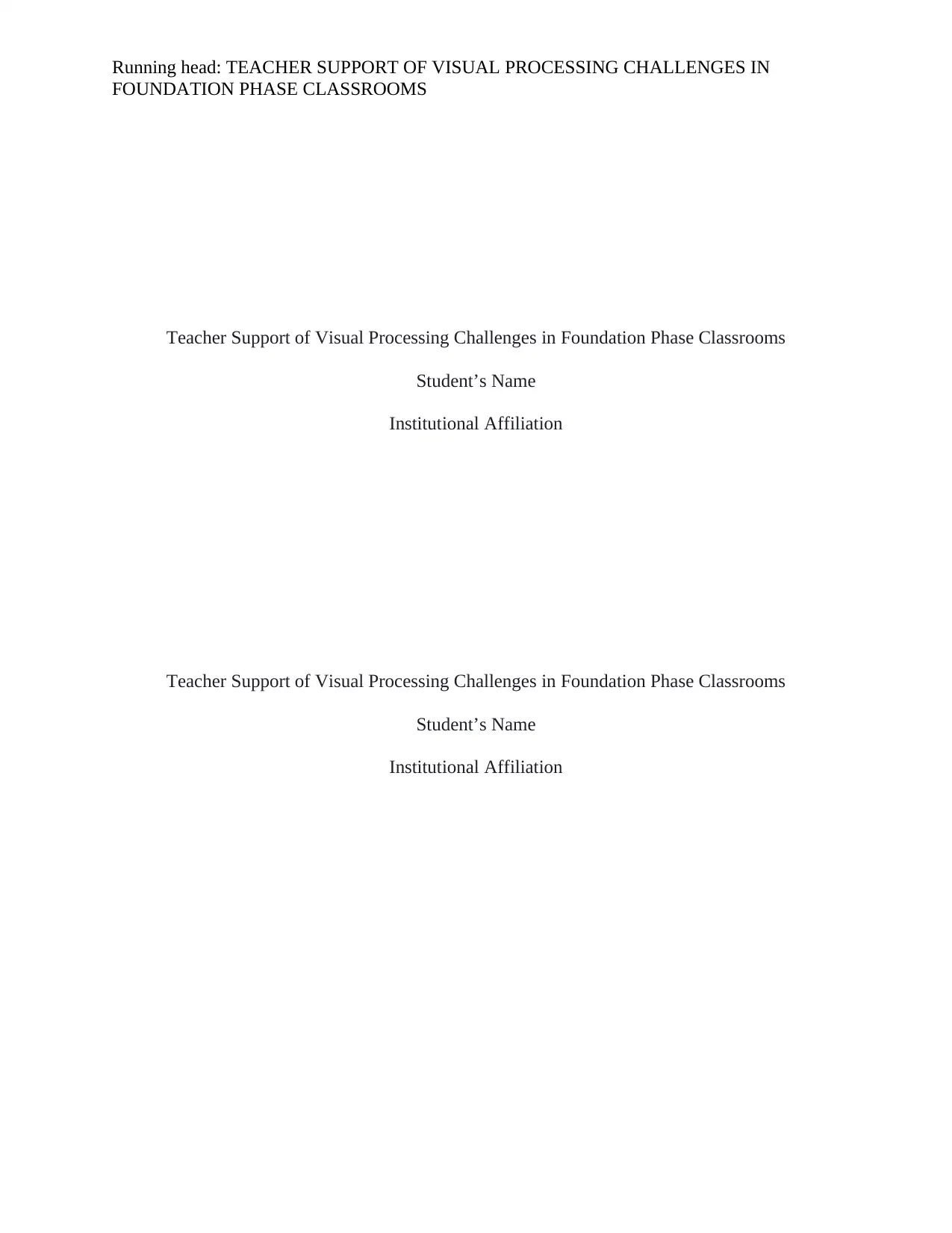
Running head: TEACHER SUPPORT OF VISUAL PROCESSING CHALLENGES IN
FOUNDATION PHASE CLASSROOMS
Teacher Support of Visual Processing Challenges in Foundation Phase Classrooms
Student’s Name
Institutional Affiliation
Teacher Support of Visual Processing Challenges in Foundation Phase Classrooms
Student’s Name
Institutional Affiliation
FOUNDATION PHASE CLASSROOMS
Teacher Support of Visual Processing Challenges in Foundation Phase Classrooms
Student’s Name
Institutional Affiliation
Teacher Support of Visual Processing Challenges in Foundation Phase Classrooms
Student’s Name
Institutional Affiliation
Paraphrase This Document
Need a fresh take? Get an instant paraphrase of this document with our AI Paraphraser
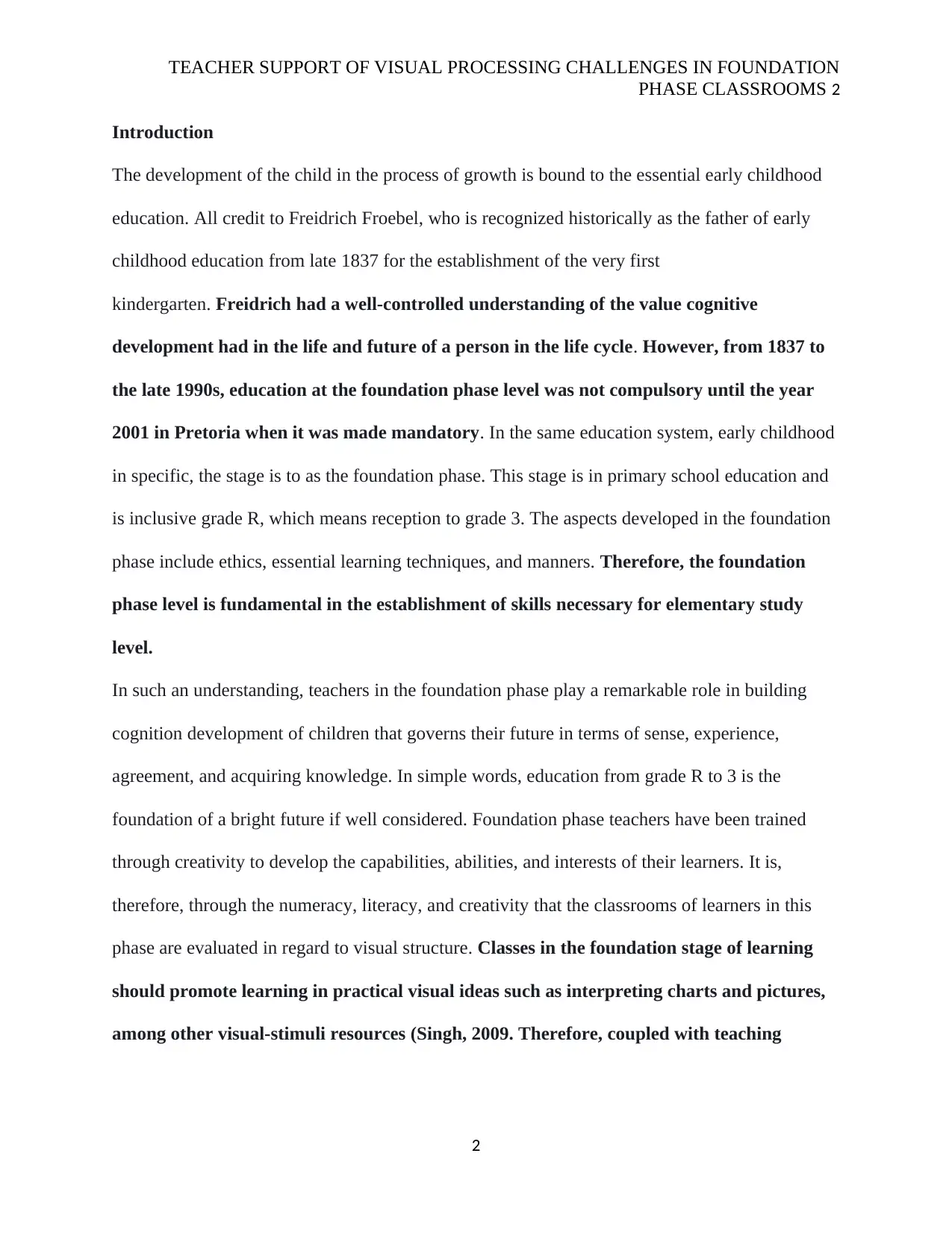
TEACHER SUPPORT OF VISUAL PROCESSING CHALLENGES IN FOUNDATION
PHASE CLASSROOMS 2
Introduction
The development of the child in the process of growth is bound to the essential early childhood
education. All credit to Freidrich Froebel, who is recognized historically as the father of early
childhood education from late 1837 for the establishment of the very first
kindergarten. Freidrich had a well-controlled understanding of the value cognitive
development had in the life and future of a person in the life cycle. However, from 1837 to
the late 1990s, education at the foundation phase level was not compulsory until the year
2001 in Pretoria when it was made mandatory. In the same education system, early childhood
in specific, the stage is to as the foundation phase. This stage is in primary school education and
is inclusive grade R, which means reception to grade 3. The aspects developed in the foundation
phase include ethics, essential learning techniques, and manners. Therefore, the foundation
phase level is fundamental in the establishment of skills necessary for elementary study
level.
In such an understanding, teachers in the foundation phase play a remarkable role in building
cognition development of children that governs their future in terms of sense, experience,
agreement, and acquiring knowledge. In simple words, education from grade R to 3 is the
foundation of a bright future if well considered. Foundation phase teachers have been trained
through creativity to develop the capabilities, abilities, and interests of their learners. It is,
therefore, through the numeracy, literacy, and creativity that the classrooms of learners in this
phase are evaluated in regard to visual structure. Classes in the foundation stage of learning
should promote learning in practical visual ideas such as interpreting charts and pictures,
among other visual-stimuli resources (Singh, 2009. Therefore, coupled with teaching
2
PHASE CLASSROOMS 2
Introduction
The development of the child in the process of growth is bound to the essential early childhood
education. All credit to Freidrich Froebel, who is recognized historically as the father of early
childhood education from late 1837 for the establishment of the very first
kindergarten. Freidrich had a well-controlled understanding of the value cognitive
development had in the life and future of a person in the life cycle. However, from 1837 to
the late 1990s, education at the foundation phase level was not compulsory until the year
2001 in Pretoria when it was made mandatory. In the same education system, early childhood
in specific, the stage is to as the foundation phase. This stage is in primary school education and
is inclusive grade R, which means reception to grade 3. The aspects developed in the foundation
phase include ethics, essential learning techniques, and manners. Therefore, the foundation
phase level is fundamental in the establishment of skills necessary for elementary study
level.
In such an understanding, teachers in the foundation phase play a remarkable role in building
cognition development of children that governs their future in terms of sense, experience,
agreement, and acquiring knowledge. In simple words, education from grade R to 3 is the
foundation of a bright future if well considered. Foundation phase teachers have been trained
through creativity to develop the capabilities, abilities, and interests of their learners. It is,
therefore, through the numeracy, literacy, and creativity that the classrooms of learners in this
phase are evaluated in regard to visual structure. Classes in the foundation stage of learning
should promote learning in practical visual ideas such as interpreting charts and pictures,
among other visual-stimuli resources (Singh, 2009. Therefore, coupled with teaching
2
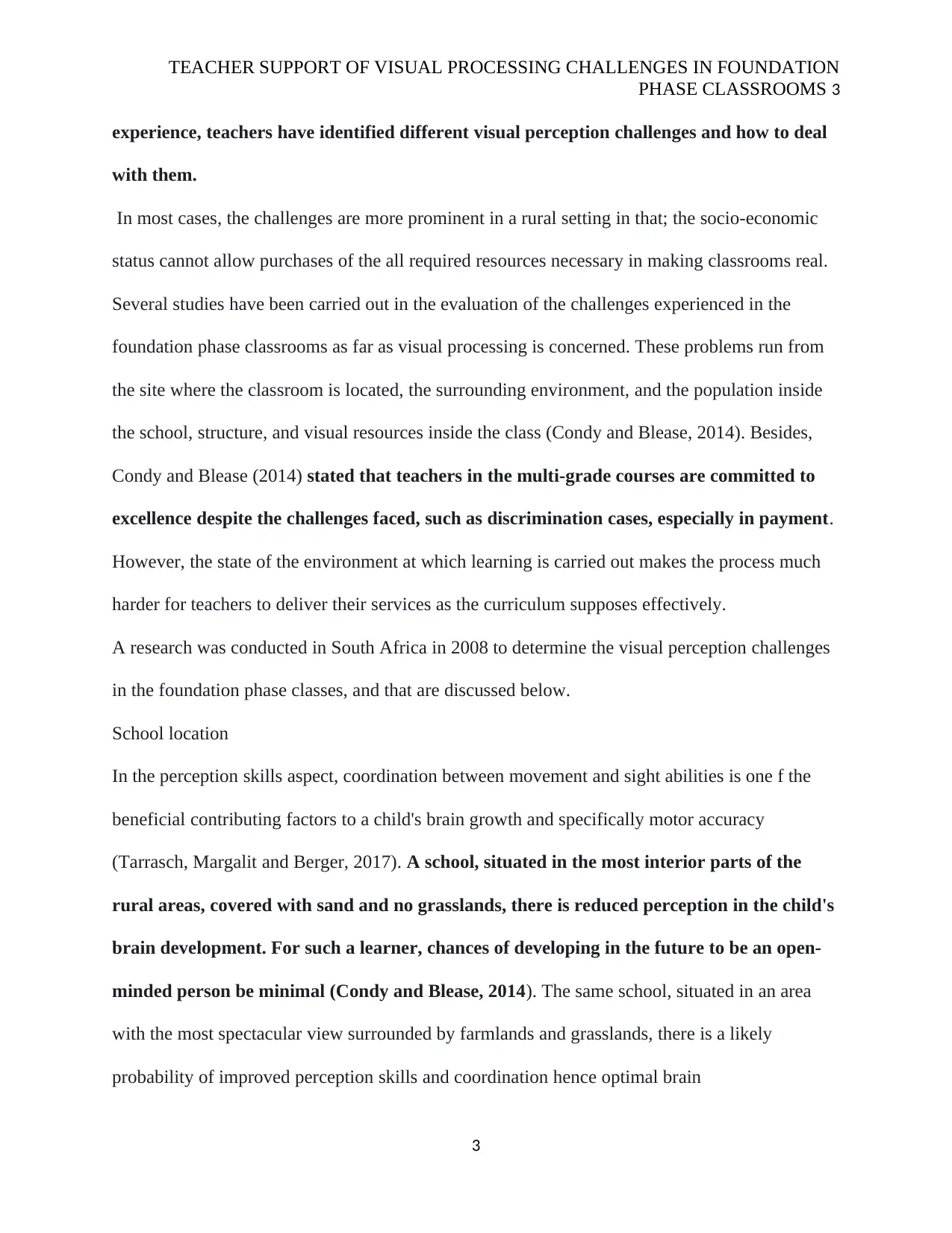
TEACHER SUPPORT OF VISUAL PROCESSING CHALLENGES IN FOUNDATION
PHASE CLASSROOMS 3
experience, teachers have identified different visual perception challenges and how to deal
with them.
In most cases, the challenges are more prominent in a rural setting in that; the socio-economic
status cannot allow purchases of the all required resources necessary in making classrooms real.
Several studies have been carried out in the evaluation of the challenges experienced in the
foundation phase classrooms as far as visual processing is concerned. These problems run from
the site where the classroom is located, the surrounding environment, and the population inside
the school, structure, and visual resources inside the class (Condy and Blease, 2014). Besides,
Condy and Blease (2014) stated that teachers in the multi-grade courses are committed to
excellence despite the challenges faced, such as discrimination cases, especially in payment.
However, the state of the environment at which learning is carried out makes the process much
harder for teachers to deliver their services as the curriculum supposes effectively.
A research was conducted in South Africa in 2008 to determine the visual perception challenges
in the foundation phase classes, and that are discussed below.
School location
In the perception skills aspect, coordination between movement and sight abilities is one f the
beneficial contributing factors to a child's brain growth and specifically motor accuracy
(Tarrasch, Margalit and Berger, 2017). A school, situated in the most interior parts of the
rural areas, covered with sand and no grasslands, there is reduced perception in the child's
brain development. For such a learner, chances of developing in the future to be an open-
minded person be minimal (Condy and Blease, 2014). The same school, situated in an area
with the most spectacular view surrounded by farmlands and grasslands, there is a likely
probability of improved perception skills and coordination hence optimal brain
3
PHASE CLASSROOMS 3
experience, teachers have identified different visual perception challenges and how to deal
with them.
In most cases, the challenges are more prominent in a rural setting in that; the socio-economic
status cannot allow purchases of the all required resources necessary in making classrooms real.
Several studies have been carried out in the evaluation of the challenges experienced in the
foundation phase classrooms as far as visual processing is concerned. These problems run from
the site where the classroom is located, the surrounding environment, and the population inside
the school, structure, and visual resources inside the class (Condy and Blease, 2014). Besides,
Condy and Blease (2014) stated that teachers in the multi-grade courses are committed to
excellence despite the challenges faced, such as discrimination cases, especially in payment.
However, the state of the environment at which learning is carried out makes the process much
harder for teachers to deliver their services as the curriculum supposes effectively.
A research was conducted in South Africa in 2008 to determine the visual perception challenges
in the foundation phase classes, and that are discussed below.
School location
In the perception skills aspect, coordination between movement and sight abilities is one f the
beneficial contributing factors to a child's brain growth and specifically motor accuracy
(Tarrasch, Margalit and Berger, 2017). A school, situated in the most interior parts of the
rural areas, covered with sand and no grasslands, there is reduced perception in the child's
brain development. For such a learner, chances of developing in the future to be an open-
minded person be minimal (Condy and Blease, 2014). The same school, situated in an area
with the most spectacular view surrounded by farmlands and grasslands, there is a likely
probability of improved perception skills and coordination hence optimal brain
3
⊘ This is a preview!⊘
Do you want full access?
Subscribe today to unlock all pages.

Trusted by 1+ million students worldwide
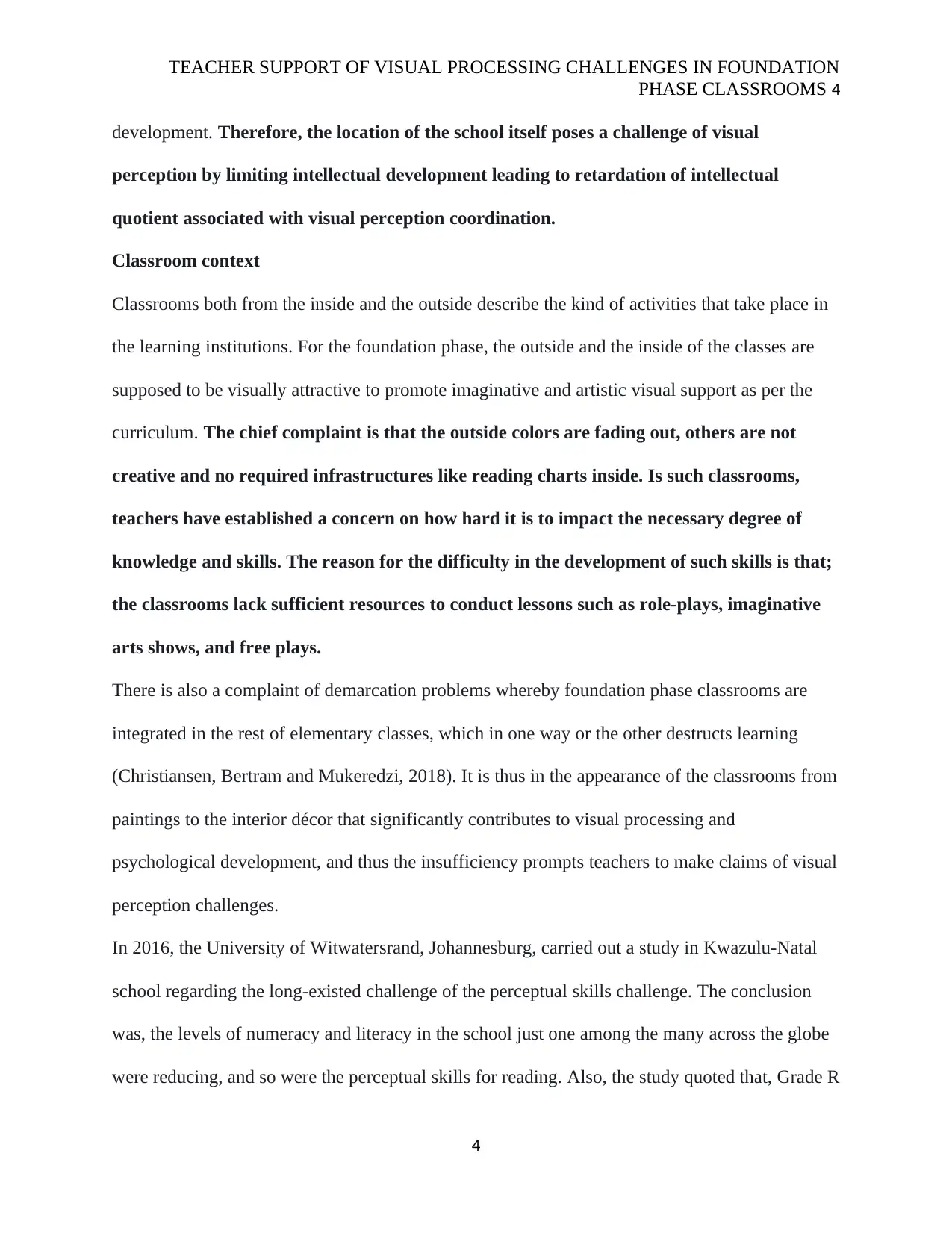
TEACHER SUPPORT OF VISUAL PROCESSING CHALLENGES IN FOUNDATION
PHASE CLASSROOMS 4
development. Therefore, the location of the school itself poses a challenge of visual
perception by limiting intellectual development leading to retardation of intellectual
quotient associated with visual perception coordination.
Classroom context
Classrooms both from the inside and the outside describe the kind of activities that take place in
the learning institutions. For the foundation phase, the outside and the inside of the classes are
supposed to be visually attractive to promote imaginative and artistic visual support as per the
curriculum. The chief complaint is that the outside colors are fading out, others are not
creative and no required infrastructures like reading charts inside. Is such classrooms,
teachers have established a concern on how hard it is to impact the necessary degree of
knowledge and skills. The reason for the difficulty in the development of such skills is that;
the classrooms lack sufficient resources to conduct lessons such as role-plays, imaginative
arts shows, and free plays.
There is also a complaint of demarcation problems whereby foundation phase classrooms are
integrated in the rest of elementary classes, which in one way or the other destructs learning
(Christiansen, Bertram and Mukeredzi, 2018). It is thus in the appearance of the classrooms from
paintings to the interior décor that significantly contributes to visual processing and
psychological development, and thus the insufficiency prompts teachers to make claims of visual
perception challenges.
In 2016, the University of Witwatersrand, Johannesburg, carried out a study in Kwazulu-Natal
school regarding the long-existed challenge of the perceptual skills challenge. The conclusion
was, the levels of numeracy and literacy in the school just one among the many across the globe
were reducing, and so were the perceptual skills for reading. Also, the study quoted that, Grade R
4
PHASE CLASSROOMS 4
development. Therefore, the location of the school itself poses a challenge of visual
perception by limiting intellectual development leading to retardation of intellectual
quotient associated with visual perception coordination.
Classroom context
Classrooms both from the inside and the outside describe the kind of activities that take place in
the learning institutions. For the foundation phase, the outside and the inside of the classes are
supposed to be visually attractive to promote imaginative and artistic visual support as per the
curriculum. The chief complaint is that the outside colors are fading out, others are not
creative and no required infrastructures like reading charts inside. Is such classrooms,
teachers have established a concern on how hard it is to impact the necessary degree of
knowledge and skills. The reason for the difficulty in the development of such skills is that;
the classrooms lack sufficient resources to conduct lessons such as role-plays, imaginative
arts shows, and free plays.
There is also a complaint of demarcation problems whereby foundation phase classrooms are
integrated in the rest of elementary classes, which in one way or the other destructs learning
(Christiansen, Bertram and Mukeredzi, 2018). It is thus in the appearance of the classrooms from
paintings to the interior décor that significantly contributes to visual processing and
psychological development, and thus the insufficiency prompts teachers to make claims of visual
perception challenges.
In 2016, the University of Witwatersrand, Johannesburg, carried out a study in Kwazulu-Natal
school regarding the long-existed challenge of the perceptual skills challenge. The conclusion
was, the levels of numeracy and literacy in the school just one among the many across the globe
were reducing, and so were the perceptual skills for reading. Also, the study quoted that, Grade R
4
Paraphrase This Document
Need a fresh take? Get an instant paraphrase of this document with our AI Paraphraser
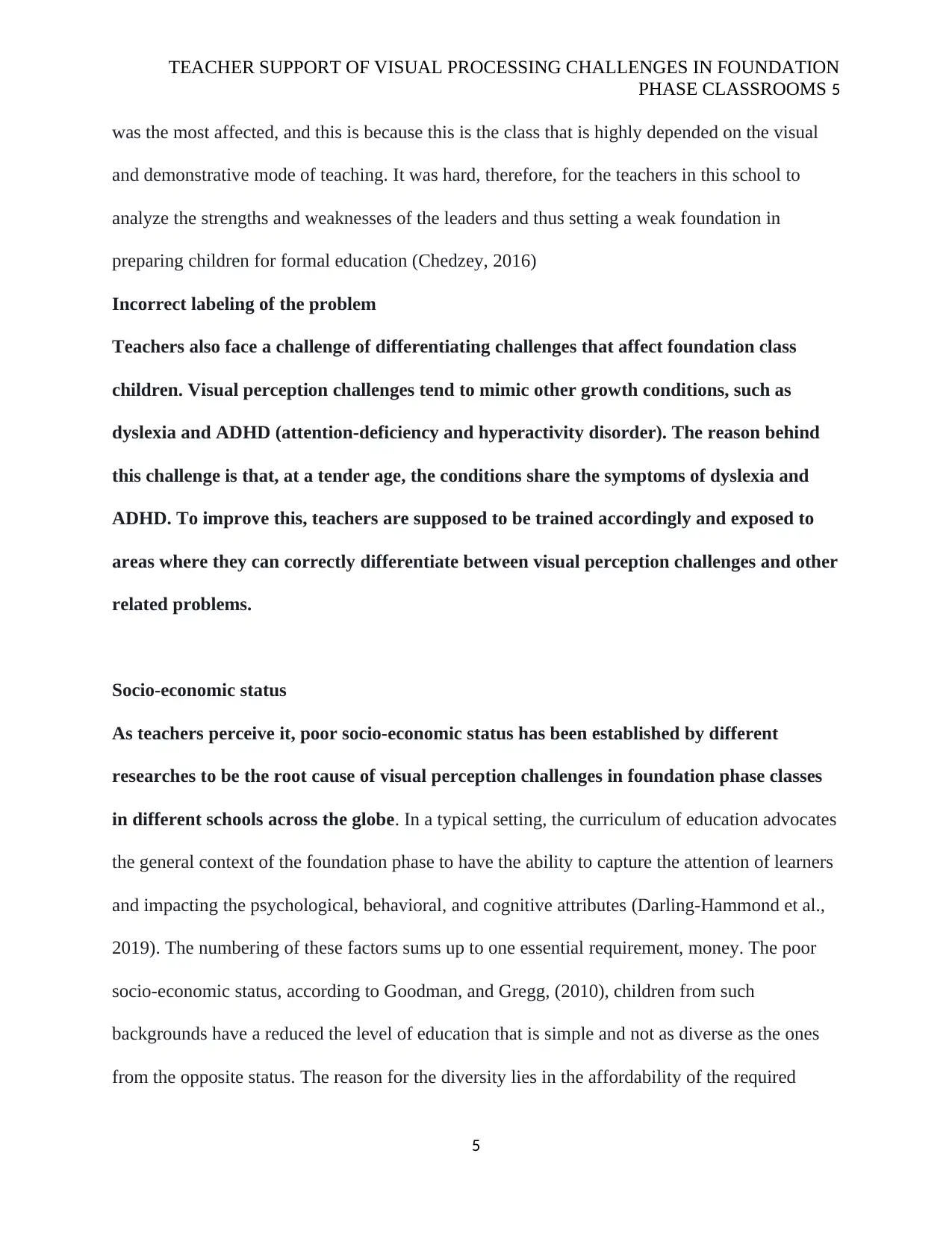
TEACHER SUPPORT OF VISUAL PROCESSING CHALLENGES IN FOUNDATION
PHASE CLASSROOMS 5
was the most affected, and this is because this is the class that is highly depended on the visual
and demonstrative mode of teaching. It was hard, therefore, for the teachers in this school to
analyze the strengths and weaknesses of the leaders and thus setting a weak foundation in
preparing children for formal education (Chedzey, 2016)
Incorrect labeling of the problem
Teachers also face a challenge of differentiating challenges that affect foundation class
children. Visual perception challenges tend to mimic other growth conditions, such as
dyslexia and ADHD (attention-deficiency and hyperactivity disorder). The reason behind
this challenge is that, at a tender age, the conditions share the symptoms of dyslexia and
ADHD. To improve this, teachers are supposed to be trained accordingly and exposed to
areas where they can correctly differentiate between visual perception challenges and other
related problems.
Socio-economic status
As teachers perceive it, poor socio-economic status has been established by different
researches to be the root cause of visual perception challenges in foundation phase classes
in different schools across the globe. In a typical setting, the curriculum of education advocates
the general context of the foundation phase to have the ability to capture the attention of learners
and impacting the psychological, behavioral, and cognitive attributes (Darling-Hammond et al.,
2019). The numbering of these factors sums up to one essential requirement, money. The poor
socio-economic status, according to Goodman, and Gregg, (2010), children from such
backgrounds have a reduced the level of education that is simple and not as diverse as the ones
from the opposite status. The reason for the diversity lies in the affordability of the required
5
PHASE CLASSROOMS 5
was the most affected, and this is because this is the class that is highly depended on the visual
and demonstrative mode of teaching. It was hard, therefore, for the teachers in this school to
analyze the strengths and weaknesses of the leaders and thus setting a weak foundation in
preparing children for formal education (Chedzey, 2016)
Incorrect labeling of the problem
Teachers also face a challenge of differentiating challenges that affect foundation class
children. Visual perception challenges tend to mimic other growth conditions, such as
dyslexia and ADHD (attention-deficiency and hyperactivity disorder). The reason behind
this challenge is that, at a tender age, the conditions share the symptoms of dyslexia and
ADHD. To improve this, teachers are supposed to be trained accordingly and exposed to
areas where they can correctly differentiate between visual perception challenges and other
related problems.
Socio-economic status
As teachers perceive it, poor socio-economic status has been established by different
researches to be the root cause of visual perception challenges in foundation phase classes
in different schools across the globe. In a typical setting, the curriculum of education advocates
the general context of the foundation phase to have the ability to capture the attention of learners
and impacting the psychological, behavioral, and cognitive attributes (Darling-Hammond et al.,
2019). The numbering of these factors sums up to one essential requirement, money. The poor
socio-economic status, according to Goodman, and Gregg, (2010), children from such
backgrounds have a reduced the level of education that is simple and not as diverse as the ones
from the opposite status. The reason for the diversity lies in the affordability of the required
5
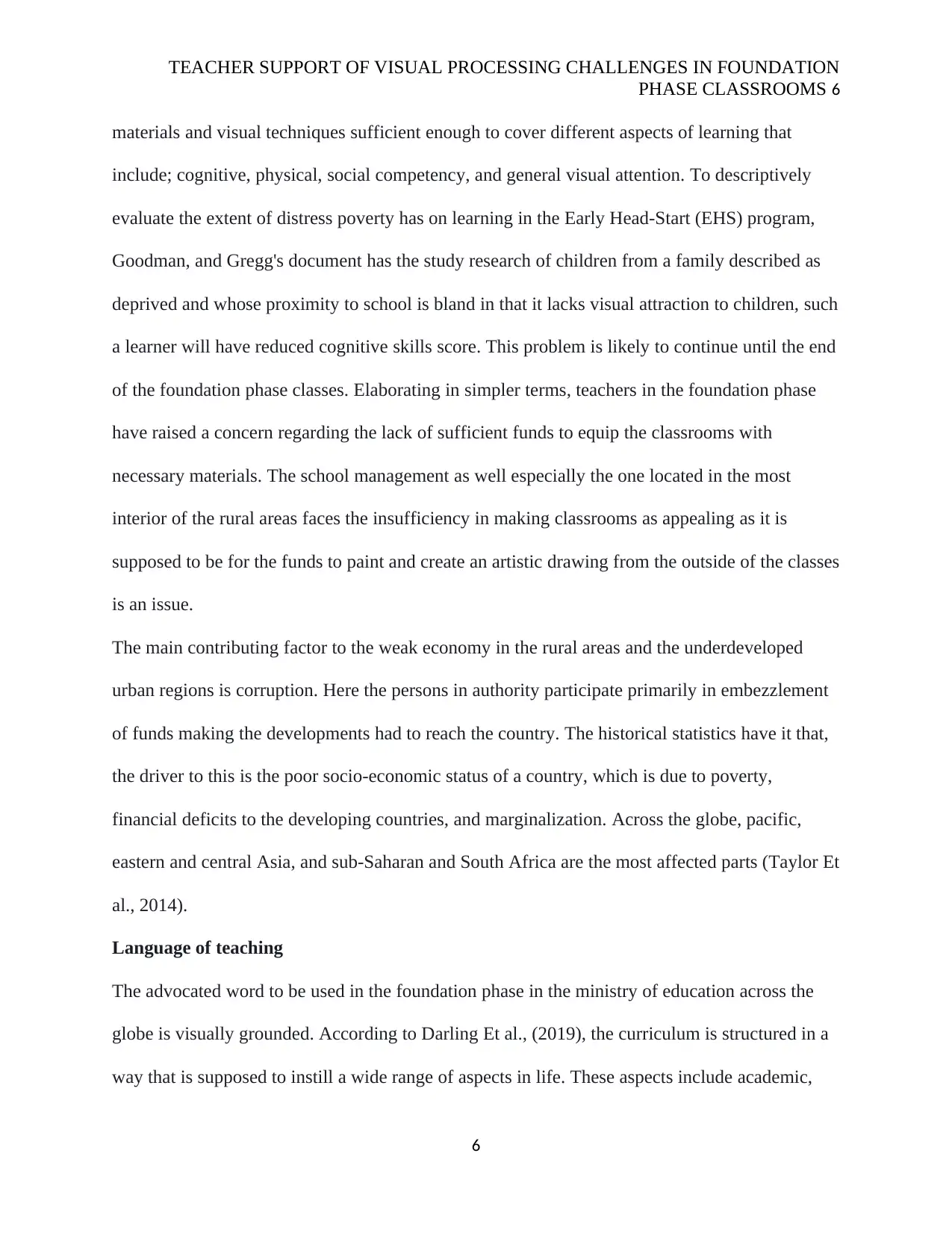
TEACHER SUPPORT OF VISUAL PROCESSING CHALLENGES IN FOUNDATION
PHASE CLASSROOMS 6
materials and visual techniques sufficient enough to cover different aspects of learning that
include; cognitive, physical, social competency, and general visual attention. To descriptively
evaluate the extent of distress poverty has on learning in the Early Head-Start (EHS) program,
Goodman, and Gregg's document has the study research of children from a family described as
deprived and whose proximity to school is bland in that it lacks visual attraction to children, such
a learner will have reduced cognitive skills score. This problem is likely to continue until the end
of the foundation phase classes. Elaborating in simpler terms, teachers in the foundation phase
have raised a concern regarding the lack of sufficient funds to equip the classrooms with
necessary materials. The school management as well especially the one located in the most
interior of the rural areas faces the insufficiency in making classrooms as appealing as it is
supposed to be for the funds to paint and create an artistic drawing from the outside of the classes
is an issue.
The main contributing factor to the weak economy in the rural areas and the underdeveloped
urban regions is corruption. Here the persons in authority participate primarily in embezzlement
of funds making the developments had to reach the country. The historical statistics have it that,
the driver to this is the poor socio-economic status of a country, which is due to poverty,
financial deficits to the developing countries, and marginalization. Across the globe, pacific,
eastern and central Asia, and sub-Saharan and South Africa are the most affected parts (Taylor Et
al., 2014).
Language of teaching
The advocated word to be used in the foundation phase in the ministry of education across the
globe is visually grounded. According to Darling Et al., (2019), the curriculum is structured in a
way that is supposed to instill a wide range of aspects in life. These aspects include academic,
6
PHASE CLASSROOMS 6
materials and visual techniques sufficient enough to cover different aspects of learning that
include; cognitive, physical, social competency, and general visual attention. To descriptively
evaluate the extent of distress poverty has on learning in the Early Head-Start (EHS) program,
Goodman, and Gregg's document has the study research of children from a family described as
deprived and whose proximity to school is bland in that it lacks visual attraction to children, such
a learner will have reduced cognitive skills score. This problem is likely to continue until the end
of the foundation phase classes. Elaborating in simpler terms, teachers in the foundation phase
have raised a concern regarding the lack of sufficient funds to equip the classrooms with
necessary materials. The school management as well especially the one located in the most
interior of the rural areas faces the insufficiency in making classrooms as appealing as it is
supposed to be for the funds to paint and create an artistic drawing from the outside of the classes
is an issue.
The main contributing factor to the weak economy in the rural areas and the underdeveloped
urban regions is corruption. Here the persons in authority participate primarily in embezzlement
of funds making the developments had to reach the country. The historical statistics have it that,
the driver to this is the poor socio-economic status of a country, which is due to poverty,
financial deficits to the developing countries, and marginalization. Across the globe, pacific,
eastern and central Asia, and sub-Saharan and South Africa are the most affected parts (Taylor Et
al., 2014).
Language of teaching
The advocated word to be used in the foundation phase in the ministry of education across the
globe is visually grounded. According to Darling Et al., (2019), the curriculum is structured in a
way that is supposed to instill a wide range of aspects in life. These aspects include academic,
6
⊘ This is a preview!⊘
Do you want full access?
Subscribe today to unlock all pages.

Trusted by 1+ million students worldwide
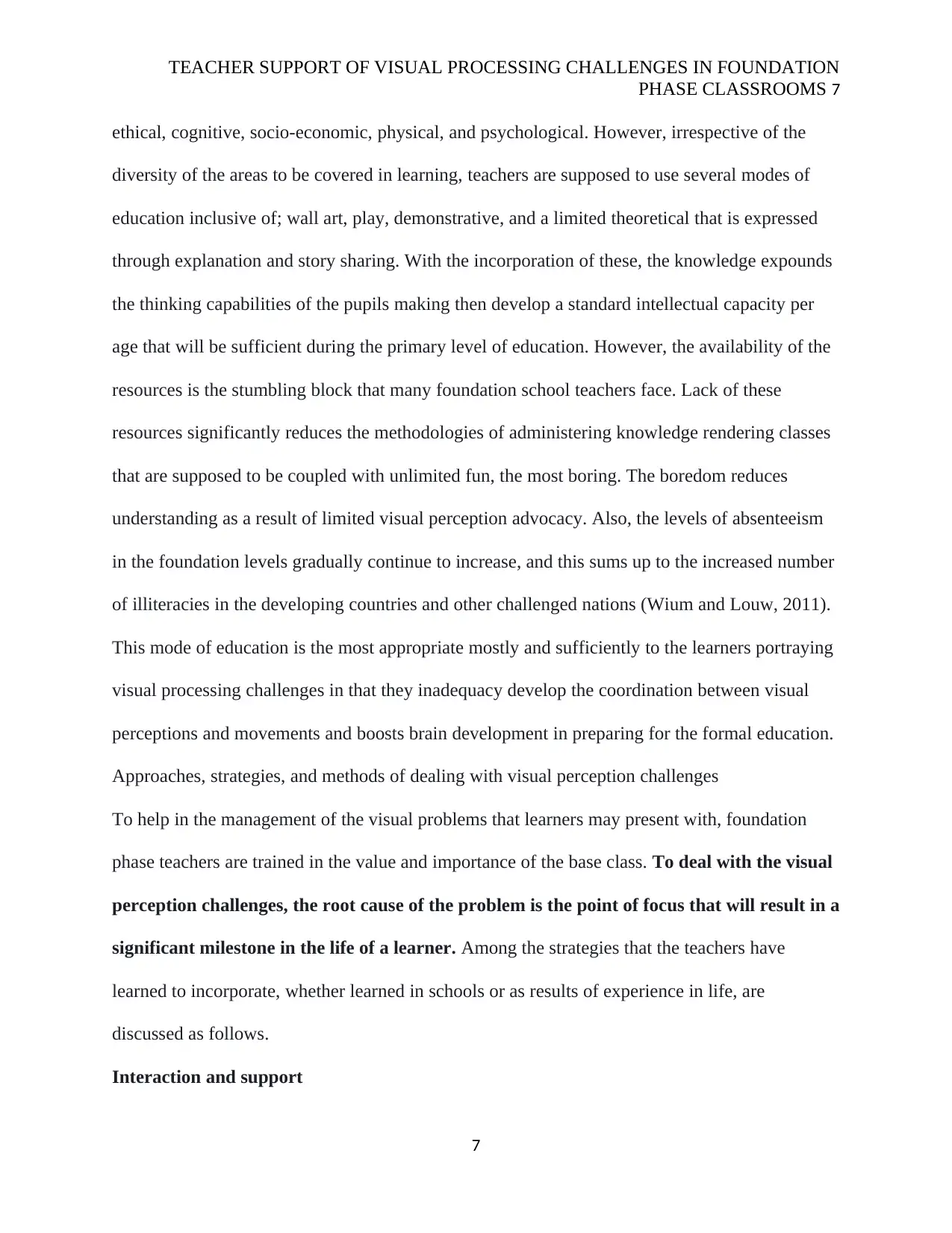
TEACHER SUPPORT OF VISUAL PROCESSING CHALLENGES IN FOUNDATION
PHASE CLASSROOMS 7
ethical, cognitive, socio-economic, physical, and psychological. However, irrespective of the
diversity of the areas to be covered in learning, teachers are supposed to use several modes of
education inclusive of; wall art, play, demonstrative, and a limited theoretical that is expressed
through explanation and story sharing. With the incorporation of these, the knowledge expounds
the thinking capabilities of the pupils making then develop a standard intellectual capacity per
age that will be sufficient during the primary level of education. However, the availability of the
resources is the stumbling block that many foundation school teachers face. Lack of these
resources significantly reduces the methodologies of administering knowledge rendering classes
that are supposed to be coupled with unlimited fun, the most boring. The boredom reduces
understanding as a result of limited visual perception advocacy. Also, the levels of absenteeism
in the foundation levels gradually continue to increase, and this sums up to the increased number
of illiteracies in the developing countries and other challenged nations (Wium and Louw, 2011).
This mode of education is the most appropriate mostly and sufficiently to the learners portraying
visual processing challenges in that they inadequacy develop the coordination between visual
perceptions and movements and boosts brain development in preparing for the formal education.
Approaches, strategies, and methods of dealing with visual perception challenges
To help in the management of the visual problems that learners may present with, foundation
phase teachers are trained in the value and importance of the base class. To deal with the visual
perception challenges, the root cause of the problem is the point of focus that will result in a
significant milestone in the life of a learner. Among the strategies that the teachers have
learned to incorporate, whether learned in schools or as results of experience in life, are
discussed as follows.
Interaction and support
7
PHASE CLASSROOMS 7
ethical, cognitive, socio-economic, physical, and psychological. However, irrespective of the
diversity of the areas to be covered in learning, teachers are supposed to use several modes of
education inclusive of; wall art, play, demonstrative, and a limited theoretical that is expressed
through explanation and story sharing. With the incorporation of these, the knowledge expounds
the thinking capabilities of the pupils making then develop a standard intellectual capacity per
age that will be sufficient during the primary level of education. However, the availability of the
resources is the stumbling block that many foundation school teachers face. Lack of these
resources significantly reduces the methodologies of administering knowledge rendering classes
that are supposed to be coupled with unlimited fun, the most boring. The boredom reduces
understanding as a result of limited visual perception advocacy. Also, the levels of absenteeism
in the foundation levels gradually continue to increase, and this sums up to the increased number
of illiteracies in the developing countries and other challenged nations (Wium and Louw, 2011).
This mode of education is the most appropriate mostly and sufficiently to the learners portraying
visual processing challenges in that they inadequacy develop the coordination between visual
perceptions and movements and boosts brain development in preparing for the formal education.
Approaches, strategies, and methods of dealing with visual perception challenges
To help in the management of the visual problems that learners may present with, foundation
phase teachers are trained in the value and importance of the base class. To deal with the visual
perception challenges, the root cause of the problem is the point of focus that will result in a
significant milestone in the life of a learner. Among the strategies that the teachers have
learned to incorporate, whether learned in schools or as results of experience in life, are
discussed as follows.
Interaction and support
7
Paraphrase This Document
Need a fresh take? Get an instant paraphrase of this document with our AI Paraphraser
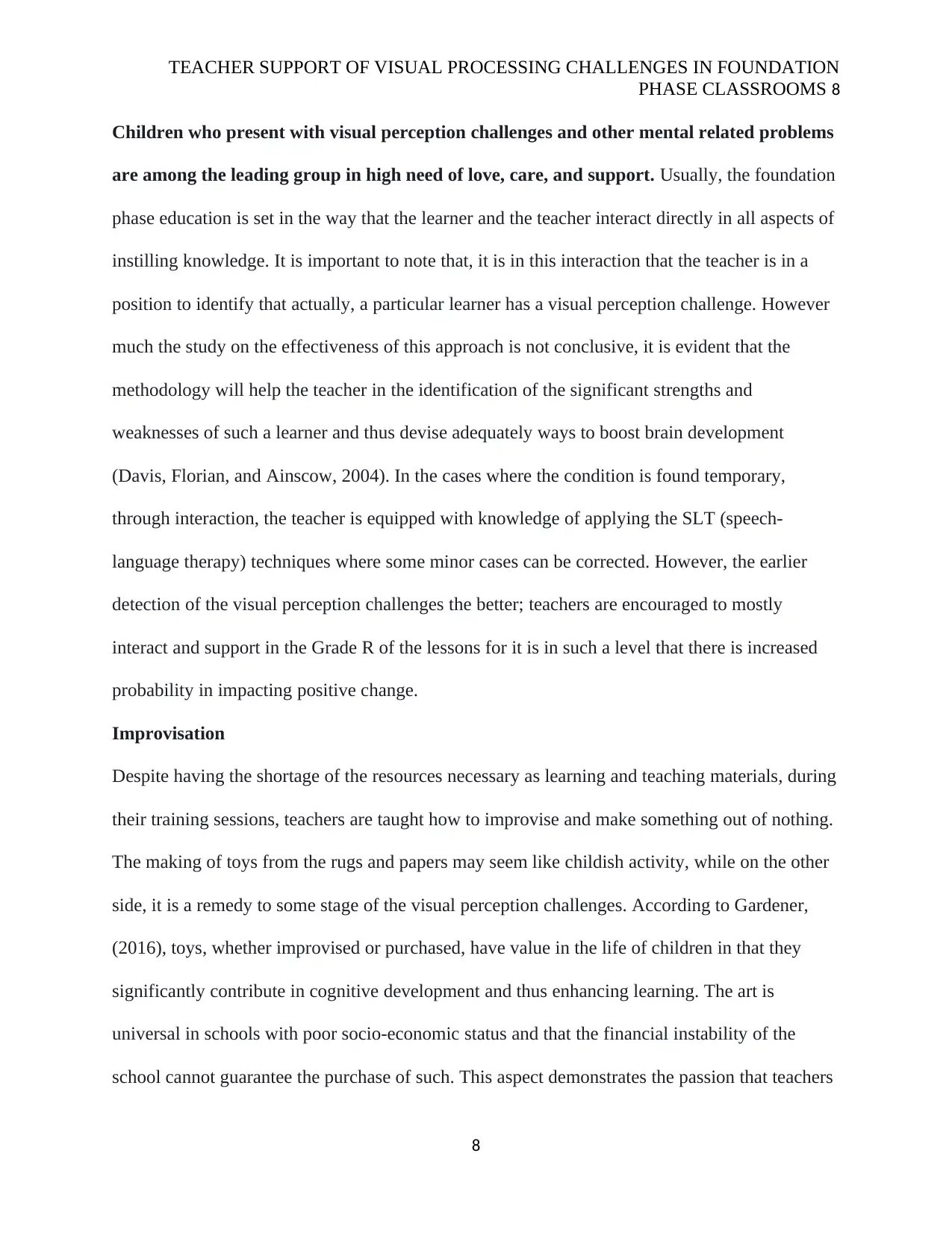
TEACHER SUPPORT OF VISUAL PROCESSING CHALLENGES IN FOUNDATION
PHASE CLASSROOMS 8
Children who present with visual perception challenges and other mental related problems
are among the leading group in high need of love, care, and support. Usually, the foundation
phase education is set in the way that the learner and the teacher interact directly in all aspects of
instilling knowledge. It is important to note that, it is in this interaction that the teacher is in a
position to identify that actually, a particular learner has a visual perception challenge. However
much the study on the effectiveness of this approach is not conclusive, it is evident that the
methodology will help the teacher in the identification of the significant strengths and
weaknesses of such a learner and thus devise adequately ways to boost brain development
(Davis, Florian, and Ainscow, 2004). In the cases where the condition is found temporary,
through interaction, the teacher is equipped with knowledge of applying the SLT (speech-
language therapy) techniques where some minor cases can be corrected. However, the earlier
detection of the visual perception challenges the better; teachers are encouraged to mostly
interact and support in the Grade R of the lessons for it is in such a level that there is increased
probability in impacting positive change.
Improvisation
Despite having the shortage of the resources necessary as learning and teaching materials, during
their training sessions, teachers are taught how to improvise and make something out of nothing.
The making of toys from the rugs and papers may seem like childish activity, while on the other
side, it is a remedy to some stage of the visual perception challenges. According to Gardener,
(2016), toys, whether improvised or purchased, have value in the life of children in that they
significantly contribute in cognitive development and thus enhancing learning. The art is
universal in schools with poor socio-economic status and that the financial instability of the
school cannot guarantee the purchase of such. This aspect demonstrates the passion that teachers
8
PHASE CLASSROOMS 8
Children who present with visual perception challenges and other mental related problems
are among the leading group in high need of love, care, and support. Usually, the foundation
phase education is set in the way that the learner and the teacher interact directly in all aspects of
instilling knowledge. It is important to note that, it is in this interaction that the teacher is in a
position to identify that actually, a particular learner has a visual perception challenge. However
much the study on the effectiveness of this approach is not conclusive, it is evident that the
methodology will help the teacher in the identification of the significant strengths and
weaknesses of such a learner and thus devise adequately ways to boost brain development
(Davis, Florian, and Ainscow, 2004). In the cases where the condition is found temporary,
through interaction, the teacher is equipped with knowledge of applying the SLT (speech-
language therapy) techniques where some minor cases can be corrected. However, the earlier
detection of the visual perception challenges the better; teachers are encouraged to mostly
interact and support in the Grade R of the lessons for it is in such a level that there is increased
probability in impacting positive change.
Improvisation
Despite having the shortage of the resources necessary as learning and teaching materials, during
their training sessions, teachers are taught how to improvise and make something out of nothing.
The making of toys from the rugs and papers may seem like childish activity, while on the other
side, it is a remedy to some stage of the visual perception challenges. According to Gardener,
(2016), toys, whether improvised or purchased, have value in the life of children in that they
significantly contribute in cognitive development and thus enhancing learning. The art is
universal in schools with poor socio-economic status and that the financial instability of the
school cannot guarantee the purchase of such. This aspect demonstrates the passion that teachers
8
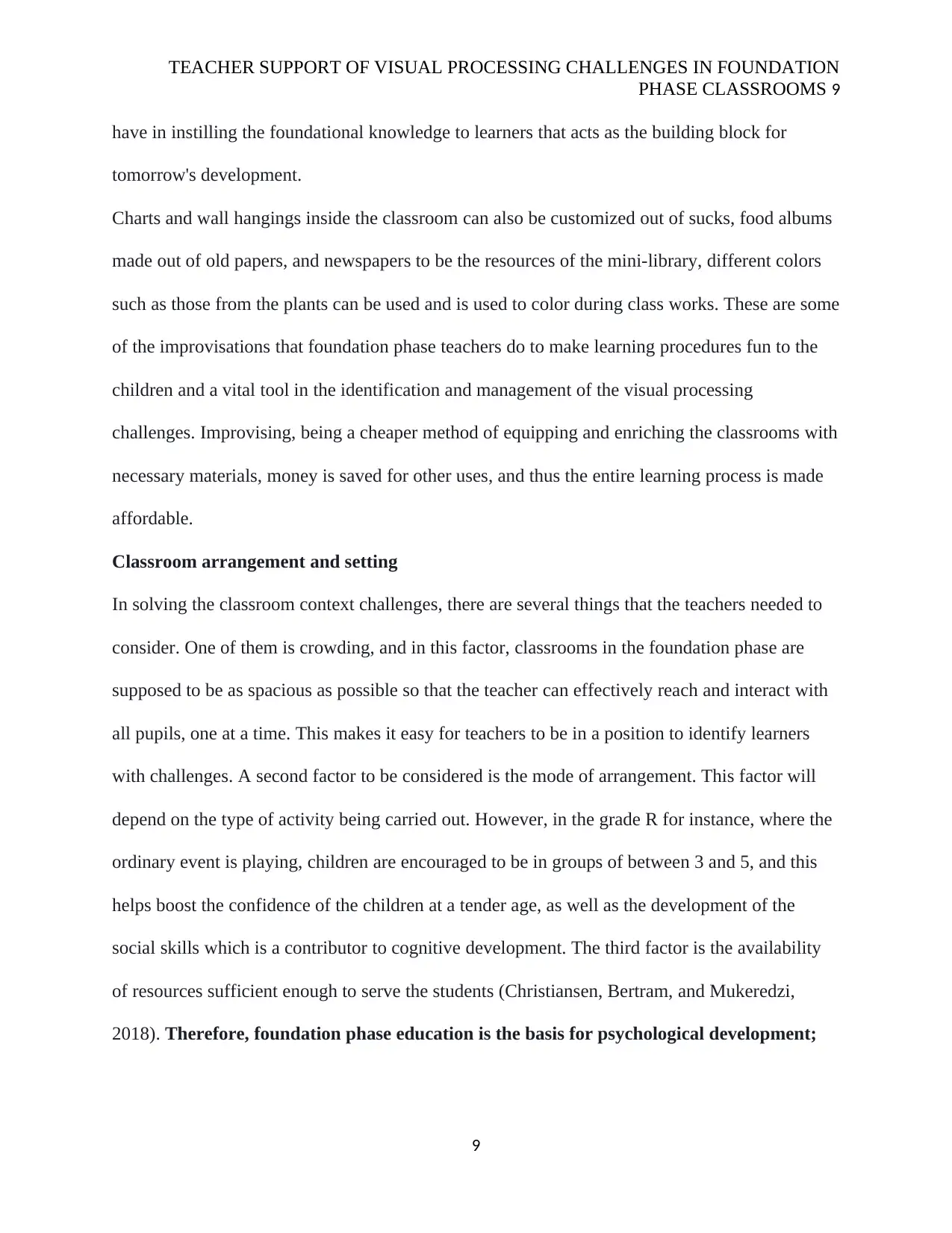
TEACHER SUPPORT OF VISUAL PROCESSING CHALLENGES IN FOUNDATION
PHASE CLASSROOMS 9
have in instilling the foundational knowledge to learners that acts as the building block for
tomorrow's development.
Charts and wall hangings inside the classroom can also be customized out of sucks, food albums
made out of old papers, and newspapers to be the resources of the mini-library, different colors
such as those from the plants can be used and is used to color during class works. These are some
of the improvisations that foundation phase teachers do to make learning procedures fun to the
children and a vital tool in the identification and management of the visual processing
challenges. Improvising, being a cheaper method of equipping and enriching the classrooms with
necessary materials, money is saved for other uses, and thus the entire learning process is made
affordable.
Classroom arrangement and setting
In solving the classroom context challenges, there are several things that the teachers needed to
consider. One of them is crowding, and in this factor, classrooms in the foundation phase are
supposed to be as spacious as possible so that the teacher can effectively reach and interact with
all pupils, one at a time. This makes it easy for teachers to be in a position to identify learners
with challenges. A second factor to be considered is the mode of arrangement. This factor will
depend on the type of activity being carried out. However, in the grade R for instance, where the
ordinary event is playing, children are encouraged to be in groups of between 3 and 5, and this
helps boost the confidence of the children at a tender age, as well as the development of the
social skills which is a contributor to cognitive development. The third factor is the availability
of resources sufficient enough to serve the students (Christiansen, Bertram, and Mukeredzi,
2018). Therefore, foundation phase education is the basis for psychological development;
9
PHASE CLASSROOMS 9
have in instilling the foundational knowledge to learners that acts as the building block for
tomorrow's development.
Charts and wall hangings inside the classroom can also be customized out of sucks, food albums
made out of old papers, and newspapers to be the resources of the mini-library, different colors
such as those from the plants can be used and is used to color during class works. These are some
of the improvisations that foundation phase teachers do to make learning procedures fun to the
children and a vital tool in the identification and management of the visual processing
challenges. Improvising, being a cheaper method of equipping and enriching the classrooms with
necessary materials, money is saved for other uses, and thus the entire learning process is made
affordable.
Classroom arrangement and setting
In solving the classroom context challenges, there are several things that the teachers needed to
consider. One of them is crowding, and in this factor, classrooms in the foundation phase are
supposed to be as spacious as possible so that the teacher can effectively reach and interact with
all pupils, one at a time. This makes it easy for teachers to be in a position to identify learners
with challenges. A second factor to be considered is the mode of arrangement. This factor will
depend on the type of activity being carried out. However, in the grade R for instance, where the
ordinary event is playing, children are encouraged to be in groups of between 3 and 5, and this
helps boost the confidence of the children at a tender age, as well as the development of the
social skills which is a contributor to cognitive development. The third factor is the availability
of resources sufficient enough to serve the students (Christiansen, Bertram, and Mukeredzi,
2018). Therefore, foundation phase education is the basis for psychological development;
9
⊘ This is a preview!⊘
Do you want full access?
Subscribe today to unlock all pages.

Trusted by 1+ million students worldwide
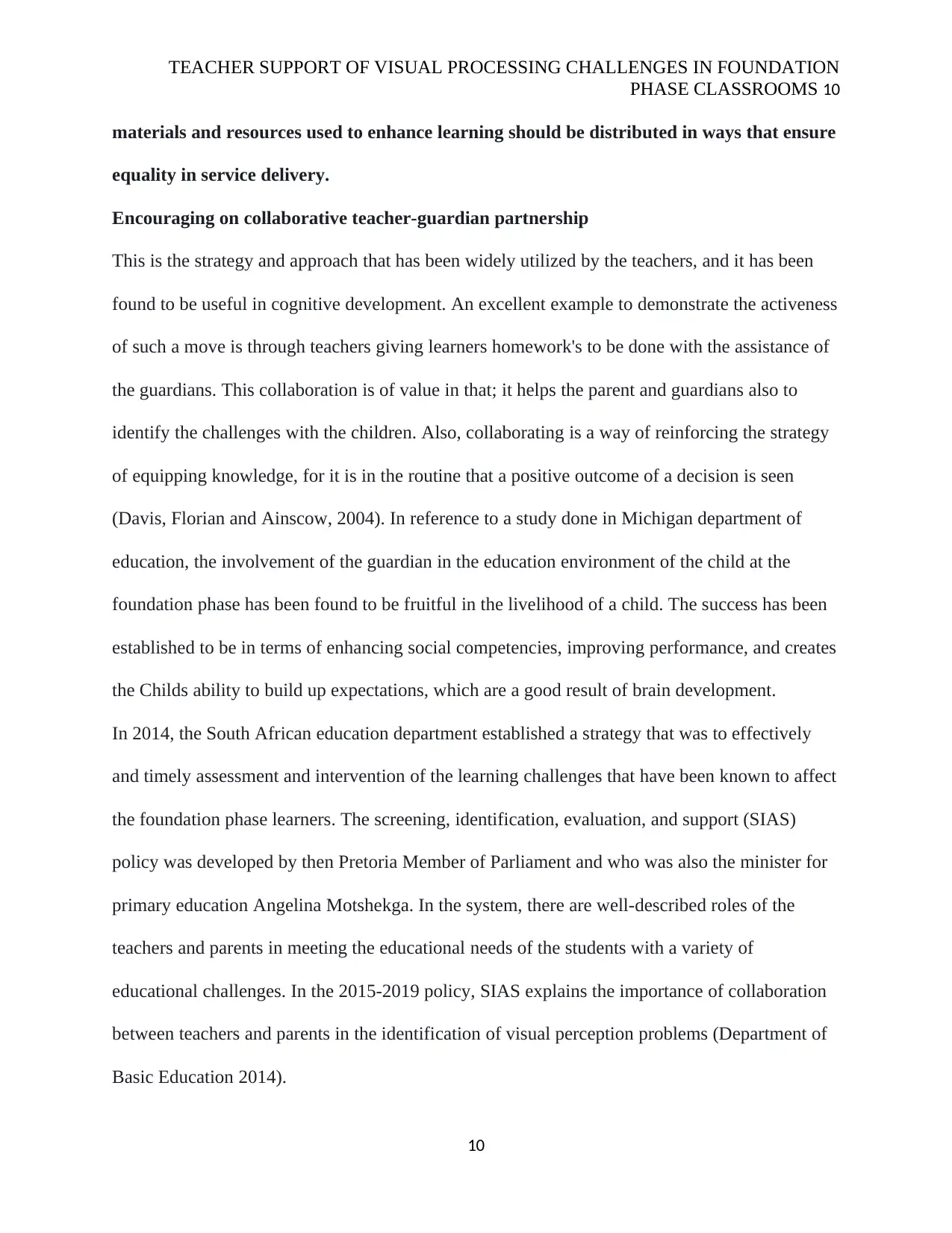
TEACHER SUPPORT OF VISUAL PROCESSING CHALLENGES IN FOUNDATION
PHASE CLASSROOMS 10
materials and resources used to enhance learning should be distributed in ways that ensure
equality in service delivery.
Encouraging on collaborative teacher-guardian partnership
This is the strategy and approach that has been widely utilized by the teachers, and it has been
found to be useful in cognitive development. An excellent example to demonstrate the activeness
of such a move is through teachers giving learners homework's to be done with the assistance of
the guardians. This collaboration is of value in that; it helps the parent and guardians also to
identify the challenges with the children. Also, collaborating is a way of reinforcing the strategy
of equipping knowledge, for it is in the routine that a positive outcome of a decision is seen
(Davis, Florian and Ainscow, 2004). In reference to a study done in Michigan department of
education, the involvement of the guardian in the education environment of the child at the
foundation phase has been found to be fruitful in the livelihood of a child. The success has been
established to be in terms of enhancing social competencies, improving performance, and creates
the Childs ability to build up expectations, which are a good result of brain development.
In 2014, the South African education department established a strategy that was to effectively
and timely assessment and intervention of the learning challenges that have been known to affect
the foundation phase learners. The screening, identification, evaluation, and support (SIAS)
policy was developed by then Pretoria Member of Parliament and who was also the minister for
primary education Angelina Motshekga. In the system, there are well-described roles of the
teachers and parents in meeting the educational needs of the students with a variety of
educational challenges. In the 2015-2019 policy, SIAS explains the importance of collaboration
between teachers and parents in the identification of visual perception problems (Department of
Basic Education 2014).
10
PHASE CLASSROOMS 10
materials and resources used to enhance learning should be distributed in ways that ensure
equality in service delivery.
Encouraging on collaborative teacher-guardian partnership
This is the strategy and approach that has been widely utilized by the teachers, and it has been
found to be useful in cognitive development. An excellent example to demonstrate the activeness
of such a move is through teachers giving learners homework's to be done with the assistance of
the guardians. This collaboration is of value in that; it helps the parent and guardians also to
identify the challenges with the children. Also, collaborating is a way of reinforcing the strategy
of equipping knowledge, for it is in the routine that a positive outcome of a decision is seen
(Davis, Florian and Ainscow, 2004). In reference to a study done in Michigan department of
education, the involvement of the guardian in the education environment of the child at the
foundation phase has been found to be fruitful in the livelihood of a child. The success has been
established to be in terms of enhancing social competencies, improving performance, and creates
the Childs ability to build up expectations, which are a good result of brain development.
In 2014, the South African education department established a strategy that was to effectively
and timely assessment and intervention of the learning challenges that have been known to affect
the foundation phase learners. The screening, identification, evaluation, and support (SIAS)
policy was developed by then Pretoria Member of Parliament and who was also the minister for
primary education Angelina Motshekga. In the system, there are well-described roles of the
teachers and parents in meeting the educational needs of the students with a variety of
educational challenges. In the 2015-2019 policy, SIAS explains the importance of collaboration
between teachers and parents in the identification of visual perception problems (Department of
Basic Education 2014).
10
Paraphrase This Document
Need a fresh take? Get an instant paraphrase of this document with our AI Paraphraser
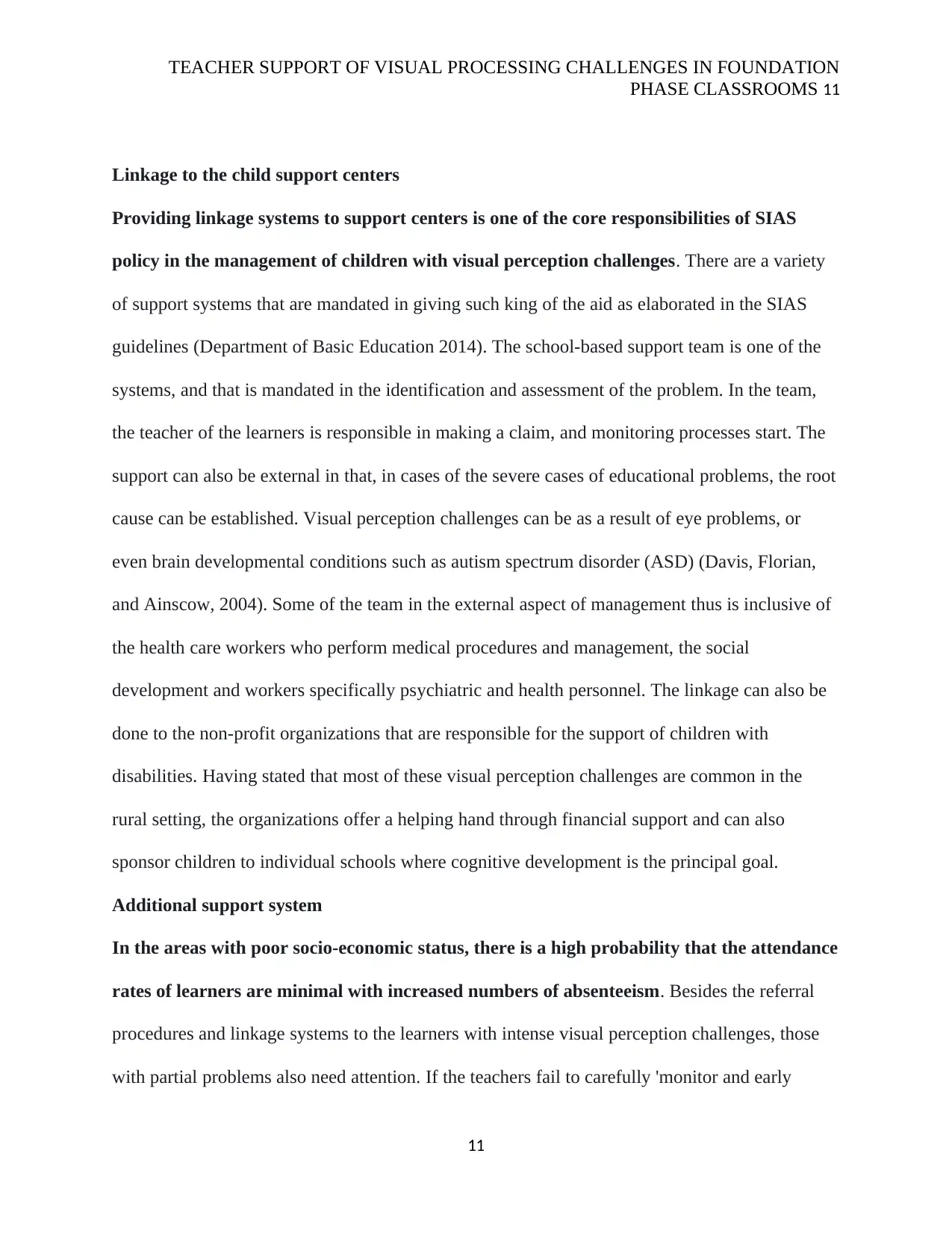
TEACHER SUPPORT OF VISUAL PROCESSING CHALLENGES IN FOUNDATION
PHASE CLASSROOMS 11
Linkage to the child support centers
Providing linkage systems to support centers is one of the core responsibilities of SIAS
policy in the management of children with visual perception challenges. There are a variety
of support systems that are mandated in giving such king of the aid as elaborated in the SIAS
guidelines (Department of Basic Education 2014). The school-based support team is one of the
systems, and that is mandated in the identification and assessment of the problem. In the team,
the teacher of the learners is responsible in making a claim, and monitoring processes start. The
support can also be external in that, in cases of the severe cases of educational problems, the root
cause can be established. Visual perception challenges can be as a result of eye problems, or
even brain developmental conditions such as autism spectrum disorder (ASD) (Davis, Florian,
and Ainscow, 2004). Some of the team in the external aspect of management thus is inclusive of
the health care workers who perform medical procedures and management, the social
development and workers specifically psychiatric and health personnel. The linkage can also be
done to the non-profit organizations that are responsible for the support of children with
disabilities. Having stated that most of these visual perception challenges are common in the
rural setting, the organizations offer a helping hand through financial support and can also
sponsor children to individual schools where cognitive development is the principal goal.
Additional support system
In the areas with poor socio-economic status, there is a high probability that the attendance
rates of learners are minimal with increased numbers of absenteeism. Besides the referral
procedures and linkage systems to the learners with intense visual perception challenges, those
with partial problems also need attention. If the teachers fail to carefully 'monitor and early
11
PHASE CLASSROOMS 11
Linkage to the child support centers
Providing linkage systems to support centers is one of the core responsibilities of SIAS
policy in the management of children with visual perception challenges. There are a variety
of support systems that are mandated in giving such king of the aid as elaborated in the SIAS
guidelines (Department of Basic Education 2014). The school-based support team is one of the
systems, and that is mandated in the identification and assessment of the problem. In the team,
the teacher of the learners is responsible in making a claim, and monitoring processes start. The
support can also be external in that, in cases of the severe cases of educational problems, the root
cause can be established. Visual perception challenges can be as a result of eye problems, or
even brain developmental conditions such as autism spectrum disorder (ASD) (Davis, Florian,
and Ainscow, 2004). Some of the team in the external aspect of management thus is inclusive of
the health care workers who perform medical procedures and management, the social
development and workers specifically psychiatric and health personnel. The linkage can also be
done to the non-profit organizations that are responsible for the support of children with
disabilities. Having stated that most of these visual perception challenges are common in the
rural setting, the organizations offer a helping hand through financial support and can also
sponsor children to individual schools where cognitive development is the principal goal.
Additional support system
In the areas with poor socio-economic status, there is a high probability that the attendance
rates of learners are minimal with increased numbers of absenteeism. Besides the referral
procedures and linkage systems to the learners with intense visual perception challenges, those
with partial problems also need attention. If the teachers fail to carefully 'monitor and early
11
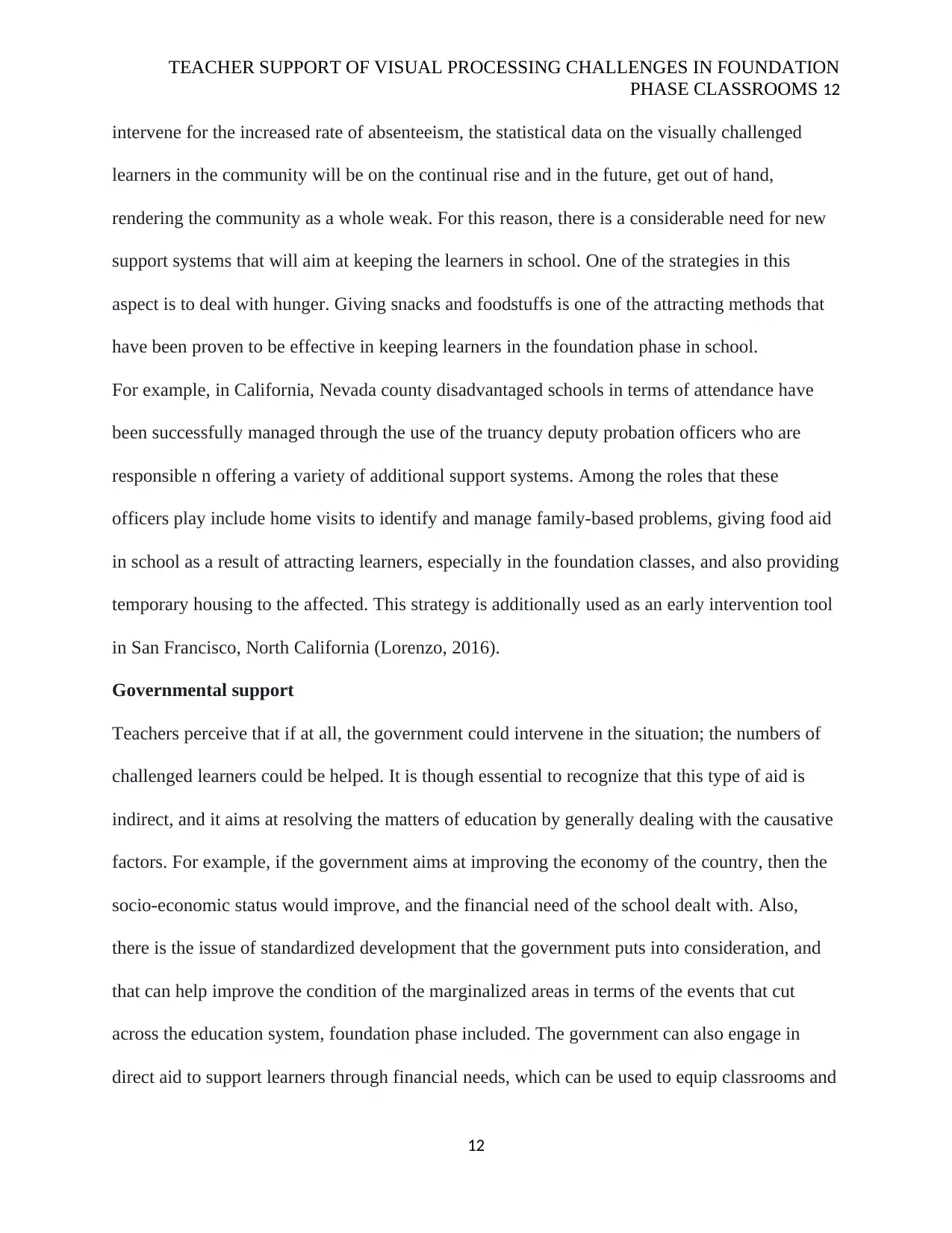
TEACHER SUPPORT OF VISUAL PROCESSING CHALLENGES IN FOUNDATION
PHASE CLASSROOMS 12
intervene for the increased rate of absenteeism, the statistical data on the visually challenged
learners in the community will be on the continual rise and in the future, get out of hand,
rendering the community as a whole weak. For this reason, there is a considerable need for new
support systems that will aim at keeping the learners in school. One of the strategies in this
aspect is to deal with hunger. Giving snacks and foodstuffs is one of the attracting methods that
have been proven to be effective in keeping learners in the foundation phase in school.
For example, in California, Nevada county disadvantaged schools in terms of attendance have
been successfully managed through the use of the truancy deputy probation officers who are
responsible n offering a variety of additional support systems. Among the roles that these
officers play include home visits to identify and manage family-based problems, giving food aid
in school as a result of attracting learners, especially in the foundation classes, and also providing
temporary housing to the affected. This strategy is additionally used as an early intervention tool
in San Francisco, North California (Lorenzo, 2016).
Governmental support
Teachers perceive that if at all, the government could intervene in the situation; the numbers of
challenged learners could be helped. It is though essential to recognize that this type of aid is
indirect, and it aims at resolving the matters of education by generally dealing with the causative
factors. For example, if the government aims at improving the economy of the country, then the
socio-economic status would improve, and the financial need of the school dealt with. Also,
there is the issue of standardized development that the government puts into consideration, and
that can help improve the condition of the marginalized areas in terms of the events that cut
across the education system, foundation phase included. The government can also engage in
direct aid to support learners through financial needs, which can be used to equip classrooms and
12
PHASE CLASSROOMS 12
intervene for the increased rate of absenteeism, the statistical data on the visually challenged
learners in the community will be on the continual rise and in the future, get out of hand,
rendering the community as a whole weak. For this reason, there is a considerable need for new
support systems that will aim at keeping the learners in school. One of the strategies in this
aspect is to deal with hunger. Giving snacks and foodstuffs is one of the attracting methods that
have been proven to be effective in keeping learners in the foundation phase in school.
For example, in California, Nevada county disadvantaged schools in terms of attendance have
been successfully managed through the use of the truancy deputy probation officers who are
responsible n offering a variety of additional support systems. Among the roles that these
officers play include home visits to identify and manage family-based problems, giving food aid
in school as a result of attracting learners, especially in the foundation classes, and also providing
temporary housing to the affected. This strategy is additionally used as an early intervention tool
in San Francisco, North California (Lorenzo, 2016).
Governmental support
Teachers perceive that if at all, the government could intervene in the situation; the numbers of
challenged learners could be helped. It is though essential to recognize that this type of aid is
indirect, and it aims at resolving the matters of education by generally dealing with the causative
factors. For example, if the government aims at improving the economy of the country, then the
socio-economic status would improve, and the financial need of the school dealt with. Also,
there is the issue of standardized development that the government puts into consideration, and
that can help improve the condition of the marginalized areas in terms of the events that cut
across the education system, foundation phase included. The government can also engage in
direct aid to support learners through financial needs, which can be used to equip classrooms and
12
⊘ This is a preview!⊘
Do you want full access?
Subscribe today to unlock all pages.

Trusted by 1+ million students worldwide
1 out of 17
Related Documents
Your All-in-One AI-Powered Toolkit for Academic Success.
+13062052269
info@desklib.com
Available 24*7 on WhatsApp / Email
![[object Object]](/_next/static/media/star-bottom.7253800d.svg)
Unlock your academic potential
Copyright © 2020–2025 A2Z Services. All Rights Reserved. Developed and managed by ZUCOL.




